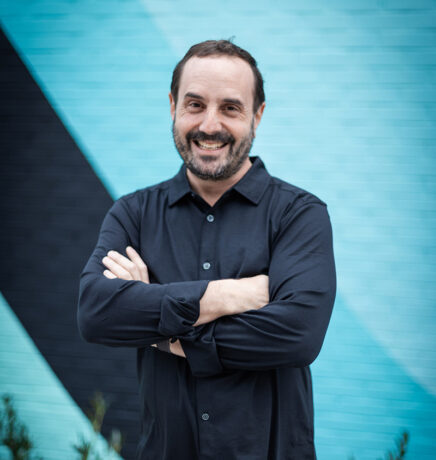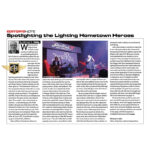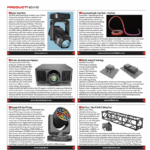
TAIT recently announced that the Private Equity business at Goldman Sachs Alternatives will acquire a majority stake in the company from affiliates of Providence Equity Partners, subject to obtaining customary regulatory approvals. Upon this announcement, PLSN reached out to Adam Davis, CEO of TAIT to discuss their place in the industry, where he sees the industry moving forward, and why clients so value TAIT.
TAIT is established as a leader in the live entertainment market. How do you see TAIT’s position in the industry today?
I think what we’ve done at TAIT, over the last 48 years, has transitioned from a company that, I would argue, put the roll in rock ‘n’ roll and was there at the beginning of it all, to one that really has become a true strategic partner across live experiences. Over the last decade plus, we’ve put a lot of energy into assembling the puzzle pieces that is TAIT today. We really set out to do a few things. Be number one anywhere we’re playing and to do the best work—not the most work—across all live experiences. We’ve built out—both organically and through acquisitions and partnerships over the years—the end-to-end capabilities to sit with our clients and really help them think through strategy and business plans. And then the ideation and storytelling that’s necessary to go deliver that business plan. Then our small army of engineers turn that into a reality that can we deploy and operate. Though we’re known for the most complicated, and, I guess you could argue, the highest production-value live concert tours in the world, we’re also doing it in a similar vein across theme parks, cruise ships, opera houses, and brand experiences.
Internally, the way we think about and operate the business today is as an army of joy makers. Many people have never heard of us, but we’re probably entertaining more audience members than any other company in the world. And that’s in the live experience market that we’re known for, the concert tours, festivals, one-offs where we’re everything from being a production partner like we are for a Taylor Swift or a Beyoncé to a full-service OEM provider, enabling from beginning to end those productions to happen. That’s a role we play on MDLBEAST Soundstorm and many other projects.
Next to the live experience, we have the location-based experience. That’s theme parks and immersive attractions. In the live world, if you look at the 20 highest grossing shows of all times, we’ve been there on every one of them. When you get into the themed experience, you’re going to find, we might be 16 out of 20. We bring a similar level of experience to where we’re able to now work with location-based experience partners. TAIT is able to take their ideas from beginning to end and execute on their behalf.
Then adjacent to that, we have placemaking, which is really using our skillset and our technology to get people off their phones and into the real world to help our clients drive their core businesses. That could be casinos, arenas, stadiums, venues like opera houses and theaters, corporate lobbies, corporate event centers. For us, it’s a huge end market because the scale of the total addressable market globally is just gigantic. We’re seeing more and more a need for our core skillset of technology-enabled storytelling in those places.
Then last, but not least for us, is the brand experience where we help our clients deliver their culture or their marketing message, both internally and externally. All these markets, they all play off each other because we’re able to help our brand clients celebrate their culture, but we also end up building out their corporate centers for them.
We’ve found the more diverse we’ve gotten, the more value that we’re able to offer to all our clients as we partner with them. We’ve seen over the years, this high production-value world that we live in just gets more and more complicated. So, the more seats that we’re able to take at the table as TAIT to help our clients, the more we’re able to assure for them that with the spectacle they get delivered they will also be getting the reliability, the safety, the quality, and the schedule, scope, and budget delivered with the professionalism that they need and expect.
What’s the vision for TAIT going forward?
I would start in the past with that question. We’ve been following the same strategy for over 15 years. It really is adding more capabilities so that we can better serve our clients, growing our geographical footprint so that we can help our clients grow geographically, and continuing to build experience up in adjacent markets. At TAIT, as we build out more skill sets and capabilities, it allows us to better serve our clients.
Our intention is to continue to do that, and to continue to grow geographically. We see this almost insatiable demand for high production-value entertainment just growing at an unclipped rate globally. We want to be there to serve and help our clients be part of that growth. We see an opportunity to continue to grow the skill sets and capabilities that we’re using to stitch together service offerings for our clients.
Of course, underlying all this is technology. We’ve started to refer to our technology platform as TXP, as the TAIT eXperience Platform and have been building this out now for years. The path that we’re on is guided by knowing that we need an operating system that lets us in a realtime, deterministic, safe, and secure way, connect together the data world and the physical world, but do it in an individualized way. In the future, the experience that you have might be different than the experience someone else has, even though you’re together at the World’s Fair for instance. We’re always working to connect together the storytelling that’s happening in the data world with the storytelling that’s happening in the physical world, in an individualized way.
That’s a path we’ve been on for a while now. And if you look at the capabilities that we’ve built up as a company from strategy and ideation, along with the deep domain expertise in engineering, and then real world physical delivery, it’s all the pieces you need to go deliver that vision. We have found that it’s one thing to have a vision on the technology and have the ability to execute the technology, but you also need to have the storytellers that see the future. It’s like if you’re living in a world with radio and you’re trying to explain television, it’s really hard unless you can go show it to them. That’s what is fun to me. That we are ideating and delivering the strategy and the ideation on that technology vision; on projects that are a decade out while we build the pieces that we need to go deliver it. That I think is going to enable us to take the entertainment that was in the proscenium, in the stadiums and arenas, and being bringing it into the real physical world. Today it’s closed ecosystems. It tends to be ticketed environments like a theme park or a cruise ship. But I think over time you’re going to see that extend. You’re starting to see airports, hotels, and eventually into all kinds of public places as we get people off their phones into the real world.
That to me is one of the things that wakes up this army of joy makers every day. It’s asking how do we go deliver that technology vision and enable storytelling to exist in a wider scale than just what started as live events and has now morphed into live experiences. I think those live experiences are going to become public experiences, everywhere over a period of time.
How will Goldman Sachs play a role in that vision?
For us, every chapter of the business has needed a different partner to help us achieve that strategy. Providence has been an exceptional partner. Now, as we look forward, we are thrilled to partner with Goldman Sachs. This collaboration will unlock new opportunities and reinforce TAIT’s position as an industry leader. TAIT has always partnered with clients across the globe. Goldman Sachs’ network and expertise will enable us to grow our global footprint and offerings. We’re the leadership team that’s been here, we’ve been practicing this craft and this mastery now for a long time. What we want from a partner is for them to say, ‘what can we do to help?’ What Goldman brings is an extended reach. Their advisor pool and relationship network are top-notch, bar none.
As we grow globally, I think you’re going to see this high production-value demand. We’re starting to see it in India, we’re starting to see it in Africa. We’re obviously highly concentrated right now in the Middle East. We’ve got offices in Riyadh, Dubai, and Abu Dhabi. So, those relationships are valuable both on the technology side as we continue to build out the strategy and the vision that I’ve just laid out, as well as on the global reach side. For TAIT, our goal is to really be in long-term partnerships with our clients. It’s to build a company that is an enabler to the media and communications ecosystem. How can we help Disney deliver their core business? How can we help Universal? How can we help Live Nation? How can we help AEG deliver their core business? In the long run, moving to long-term partnerships so that we can be even more strategically aligned with what we’re trying to achieve, and what they’re trying to achieve; to better serve both companies. That’s something that Goldman Sachs are uniquely situated to help us with as we continue to pioneer and explore how to go do that.”
Why do you think TAIT is so valued by your clients?
I will say we’ve built the company by doing what we say we’re going to do and serving our clients and their clients. If you look at the tenure of the company, we do a pretty good job of retaining our clients, serving them over and over again. And always adding more and keeping them. I think it comes from a mindset that the client comes first. We’re here to serve and serving them sometimes is helping them see things that they might not have even seen. It’s helping them see that they might be asking the wrong question. We say, ‘What about this?’ If you ask this question, you can offer a different strategy that might help the client be more successful. And very importantly, we deliver. We do what we say we’re going to do, end stop. I can give you a thousand examples of trying to do everything we can to make it happen.
I also think we’re unique in putting a flag in the ground and saying, we’ve done projects on all seven continents, outer space, and in every ocean at this point. That doesn’t come without every day there being obstacles, but in some ways it’s an insurance policy dealing with those obstacles. Because we know everyday, there’s going to be a live experience today and it’s going to have the spectacle that’s necessary to deliver the value that we’re talking about. And we make sure it’s also going to come with safety and reliability and operational savings and all the thought process we put behind it. We’re going to make sure that it runs as smoothly as possible and it’s going to be practical from a business perspective. We’re here on behalf of our clients to help them not only realize their artistic vision, but maybe even push the artistic vision to deliver a business plan that’s rational, profitable and successful for them.
Is there anything else you’d like to mention about TAIT moving into the future?
On any given day, I think ‘how lucky are we?’ We’re getting to work with clients who are so passionate about what they do and are so talented. We’ve managed to create, as a company, a culture now that attracts the best talent in the world. Really, the trick is creating a culture where anybody’s idea could be the best idea. We’ve created a culture where we’re able to bring together a software programmer and a sculptor and a story writer and an illustrator and a physicist and put a challenge on the table and collectively solve that problem in a way that is exploring what’s impossible. That’s the secret sauce to it all. In so many ways, it goes back to Michael Tait and his genius brain of we’re not shooting for 99%, we’re shooting for 100%, and that last 1% is unachievable. So, that idea that we’re just constantly trying to explore and innovate and over time we don’t really invent things, it’s about constantly making incremental improvements. We’re just constantly not satisfied with what we’ve done, what’s out there, we are always trying to improve. That is how innovation happens. It’s fun to be part of, to see. It’s fun to pull back and watch the army of joy makers around the world delivering.
Michael Tait really put that idea across the company of working to achieve the last 1% and Winky [Fairorth] has really put the idea across the company of building relationships and treating those relationships like partners. Doing the right thing by people. It is that simple. It’s not about making the last dollar or squeezing the margin; it’s just about doing the right thing by everybody so that we want to come back together and do it again. When you put that all together, you get a really positive outcome.


